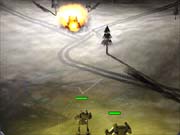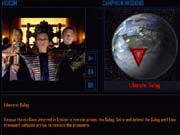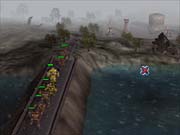While the concept of piloting giant metal killing machines has been popular in the first-person combat genre thanks to the MechWarrior series, the attempt to transfer this concept to the strategy genre in 1998's MechCommander met with limited success. This is surprising, since the original game implementation of this universe was the BattleTech tabletop board game that was the epitome of strategic gaming. Almost exactly three years later, Microsoft has revamped its original mech strategy game in MechCommander 2. Yet, the more things change, the more they stay the same, because while the developers have clearly addressed key flaws in the original, the finished product still suffers from some of the same design drawbacks that plagued MechCommander 2's predecessor. Fortunately, MechCommander 2 also manages to capture enough of the spirit of BattleTech to make it enjoyable in spite of this.

While MechCommander 2 is a real-time strategy game, it often feels a little more like a role-playing game. That's because your ultimate success will depend on the experience and equipment you gain from mission to mission. In true BattleTech style, the game is all about improving your forces with new technology, equipping them with the right mix of weapons, and continuing to improve the skills of your pilots. It's this sense of accumulation and improvement that drives the single-player game forward, and it's also the main obstacle to the game's replay value.
The first MechCommander had some noticeable shortcomings. You couldn't set waypoints, and mechs had a tendency to stand still while engaged in combat. In addition, you couldn't select units without clicking on them, and you couldn't save during missions. Microsoft must have paid attention to the complaints, because these and various other deficiencies have been addressed in the sequel. You can now save your progress during missions. Waypoints can be set separately for walking, running, and jumping movement modes, and mechs engaged in combat dart here and there, generally firing on the run (though with odd exceptions). Units can now also be grouped, and you can select these groups using keystrokes. The waypoints help tremendously, as does the improved artificial intelligence of your pilots. Unfortunately, there are still some problems with maintaining a given distance from an enemy--even with orders to stay at long range, mechs tend to close in so that they can use more weapons. Whereas MechCommander's mechs were a bit too passive, the sequel has nudged them too far in the opposite direction. They'll engage enemies on sight, but this means that if you lose track of a battle, you'll often find some of your pilots wandering across the map, chasing an enemy you hadn't even noticed.

Otherwise, MechCommander 2 sticks to the same formula present in the original game: a linear campaign driven by excellent cutscenes. The story itself isn't that engaging, but its presentation definitely is. The full-motion video clips are quite entertaining, especially a recurring talk show, which is clearly a spoof of The McLaughlin Group. Some of the acting is outstanding for a computer game, especially that of Rick Deats, who gives an appropriately over-the-top performance as Colonel Renard. The result is one of those rare games, much like Command & Conquer, where you'll actually look forward to seeing the next cutscene.
Sadly, the actual campaign itself is much less interesting. The missions are strictly linear, with fixed objectives and enemies that are triggered by moving your units within sensor range. Objectives are numbered sequentially, and in most cases, this corresponds to a logical order in which they must be completed. This means that you don't even have the option of taking a radically different tactical approach to the battles on subsequent playings of the campaign (although you could try to win with different mech combinations). Some missions are so linear that straying even slightly from the script spells doom, like when you're given exactly enough resource points to salvage certain enemy mechs, which you then use to complete the mission with the help of some additional pilots that magically arrive to aid you. You also get plenty of voice-over advice, which helps to create a nice atmosphere the first time through but limits the replay value subsequently.
That said, the persistent nature of the campaign world makes the initial playing a rewarding experience even for those who might not be fans of the BattleTech concept. In fact, more casual fans will likely enjoy the game even more than the diehards, since MechCommander 2 still hasn't quite found a good way to portray the concept of mech heat management in a strategic format. Now, there is an overall heat limit you must take heed of when designing mechs, but once you're in combat, heat isn't an issue. Since heat is one of the foundations of the whole BattleTech premise, fans of more hard-core treatments of this in different genres (like in the classic MechWarrior 2) might find that MechCommander 2 doesn't quite translate the feel of these other mech games. A similar complaint can be made about targeting various mech body parts, which can be done in MechCommander 2 but isn't the fundamental strategy lynchpin that it is in other BattleTech games. Still, it retains enough of the flavor of mech combat to keep your interest, and the battles themselves involve a fair amount of strategic planning. The addition of support elements (such as air strikes, fixed artillery scout copters, and more) that you can buy with resource points while in a particular mission adds to the strategic choices.

MechCommander 2 is a fast-paced game by strategy standards, and as such, orders can be issued in paused mode. In fact, many players will probably find themselves spending more time in pause mode during combat than out of it. For this reason, it's strange that Microsoft didn't make the pause mode easier to use. You have to wait for a system menu to pop out of the right side of the screen, and once paused, you can't see what orders you've issued--there are no graphical indicators to show where a mech has been told to go or which target he's firing at. For something that's so crucial to the gameplay, the pause mode seems like an afterthought.
Another basic BattleTech concept is the ability to customize and equip your mechs, and this is a key feature of MechCommander 2 as well. Battlefield salvage yields a variety of mech weapons and chasses, and as you progress through the campaign, you'll find yourself tinkering with mech loadouts to find appropriate designs for the various missions. Since MechCommander 2 does away with fog of war on the map, you can survey the terrain and get a detailed picture of the situation to inform your force selection choices. The only problem is that since there is no skirmish mode (there isn't even the option to fight computer opponents in multiplayer), your mech design skills in solo mode will be confined to the campaign--unless you can find some live opponents. This is perhaps the most disappointing aspect of the game, because the heart of the BattleTech experience is designing the perfect mech and testing it against various other designs. But in MechCommander 2, you're essentially confined to multiplayer once you've finished the campaign. There is a mission editor in the game, and you can create new missions as well as download others' missions. But this isn't a good substitute for a configurable skirmish mode in a strategy game. The lack of a skirmish mode is mitigated somewhat by the ability to use maps from the campaign missions you've completed as stand-alone missions to test mech designs.
Like the original MechCommander, the sequel looks absolutely great. The mechs are nicely detailed, explosions and other weapons effects are excellent, and the terrain is destructible--you can even walk over a tree with your mech and watch it fall over. The sound effects go nicely with the graphics, and from a technical standpoint, MechCommander 2 does a much better job with 3D than some other recent real-time strategy games. The maps are a little homogenous, but the actual terrain effects on line of sight make for some interesting strategic situations. Sensor contacts become important since getting the jump on your enemy can give you a significant advantage if you can make your first strike count.

The similarities to the original MechCommander extend to the technical requirements--you really need a top-end machine to run the game properly. Even on a high-end test system, though, the graphics engine seemed to bog down with a lot of objects in play. Even worse, this extends to keystroke and mouse-click recognition--at times, it becomes difficult to select units or even pause the game, so you'll end up reloading. Load times are similarly long, and in some cases, dreadfully so. While this has something to do with hardware, the simplest thing to do is to turn various graphics options (especially shadows) off. Unfortunately, if you do this, you won't be able to experience the game in its full glory.
MechCommander 2 is a significant improvement upon the original in numerous ways, particularly in the interface. At the same time, it fails to address the more general design issues that kept its predecessor from being the ideal strategic implementation of the BattleTech universe. Although it falls short of being a strategic version of MechWarrior 2, MechCommander 2 still has so much going for it that only the most die-hard BattleTech fans will be disappointed. Those simply looking for a visually impressive, enjoyable real-time strategy game set in the BattleTech universe should find that MechCommander 2 fits that description well.